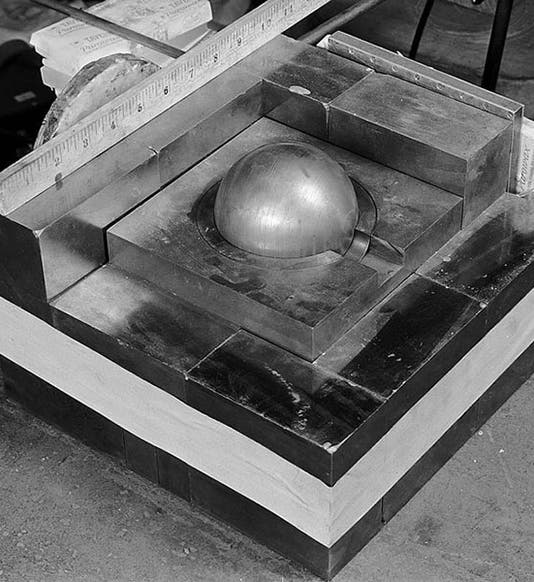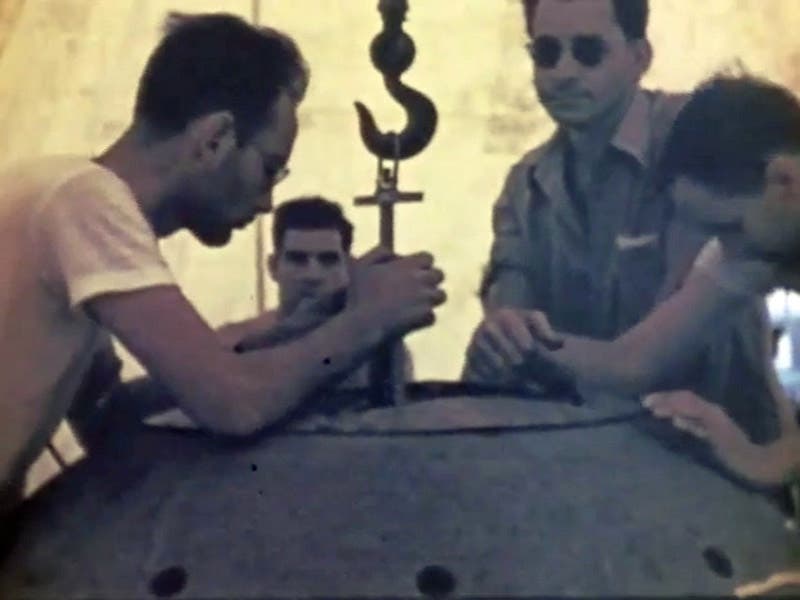Scientist of the Day - Harry Daghlian
Harry Daghlian, an Armenian/American physicist, died Sep. 15, 1945, the first peacetime fatality of the Manhattan Project, the U.S. Army's top-secret program to develop an atomic weapon. Daglian studied physics at MIT and Purdue, and was still a graduate student when his advisor at Purdue was invited to Los Alamos by Robert Oppenheimer, and Daghlian was asked to come along. He was apparently a bright and personable young man, and he was soon part of the Critical Assembly Team, headed up by Otto Frisch, which was responsible for putting the bombs together – the Trinity “Gadget,” as well as the two bombs intended for Japan. Assembling a nuclear weapon requires a certain amount of cool detachment, along with considerable technical expertise. In a photo taken on the Trinity tower in mid-July 1945, Daghlian is the face in the background; his friend Louis Slotin is the figure on the right (second image).
The Critical Assembly team did its job well. The Trinity Gadget was successfully tested on July 16, 1945; the uranium bomb was dropped on Hiroshima on Aug. 6; the plutonium bomb on Nagasaki on Aug. 9; and the Japanese surrendered on Aug. 14, 1945. But still the experimentation went on. The circumstances leading up to criticality were still poorly understood. A bomb core achieves criticality when at least one neutron from each fission event (splitting of an atom) causes another fission event, producing what is often called a chain reaction. If too many neutrons escape the core without striking another nucleus, then no such reaction occurs.
So, on Aug. 21, 1945, Daghlian sat in a remote lab near Los Alamos, New Mexico, with a 14-pound spherical core of plutonium, fresh from the nuclear reactors at Hanford, Washington, on the bench before him. The plutonium core was subcritical, meaning that by itself it could not initiate or sustain a nuclear reaction – the surface area was too large compared to the volume, so that too many neutrons escaped before they could cause plutonium atoms to fission. But what if some of those escaping neutrons were deflected back into the core? That was what Daghlian was investigating. He had a stack of custom-shaped tungsten-carbide bricks that he was arranging around the core. Tungsten carbide is an excellent neutron reflector, so it was likely that if one were to surround the core with bricks, it might well go critical. No one wanted that, of course, but they did want to know how the reaction changed as more and more neutrons were turned back into the core. There were lots of instruments in the room that gave audible indications of any increase in radioactivity from the experiment. Our first photo shows a recreation of the experiment, with the round plutonium core half-surrounded by the tungsten-carbide bricks. Daghlian, by the way, was working at night, with only one other person, a guard, in the room.
Daghlian stacked up bricks one by one around the sides of the core, and the Geiger counters chattered more and more frequently; the reflectors were working just as predicted. Richard Feynman called this process “tickling the dragon’s tail.” As Daghlian began to close off the top of his brick box, the detectors went crazy, indicating that the "dragon" was close to being awakened. He attempted to pull back the brick that he had in his hand, but instead, he dropped it, right onto the core. The core went super-critical, and there was an intense blue flash of radiation, which ceased only when Daghlian grabbed the brick and pulled it out. There was never a danger of explosion. But poor Daghlian had received a bath of neutrons and gamma rays more intense than any civilian had ever suffered, more even than the unfortunate victims of Nagasaki, who had endured their moment of plutonium super-criticality just 12 days before. As his hand swelled and the skin sloughed away, and as the organs of his body slowly shut down, Daghlian drifted to an unpleasant death, 26 days later. He was only 24 years old.
The plutonium core survived unscathed, and incredibly, 9 months later, it was again used in an experiment studying criticality. The experimenter this time was Louis Slotin, Daghlian’s friend, and the experiment was slightly different, with a beryllium hemispherical shell being used for a reflector, but Slotin too let it slip, and he was subjected to an even more intense radiation burst, dying 9 days later. A little too late, administrators decided that such criticality experiments were best done remotely, without humans present. Daghlian and Slotin were the only two people to die as the result of a criticality experiment in the entire history of Los Alamos.
The plutonium core that had snuffed out the lives of two promising young physicists was given the name, the "demon core," and nobody wanted anything to do with it. It was intended for use in Operation Crosswords in July of 1946, when two bombs were exploded in tests at Bikini Atoll, but the demon core was still too radioactive to handle, so it was not used, and it was eventually melted down and incorporated into other plutonium cores, losing its identity in the process.
Because of secrecy restrictions, for a long time no one knew what had happened to Daghlian. I came across a government investigative report of 1956 – 11 years after the incident – that described the accident, but Daghlian was not mentioned by name. I do not know when the full details became available, but the story eventually came out, and in 2000, in his boyhood home of New London, Connecticut, Daghlian was remembered in a ceremony, with the unveiling of a memorial stone (third image).
William B. Ashworth, Jr., Consultant for the History of Science, Linda Hall Library and Associate Professor emeritus, Department of History, University of Missouri-Kansas City. Comments or corrections are welcome; please direct to ashworthw@umkc.edu.









